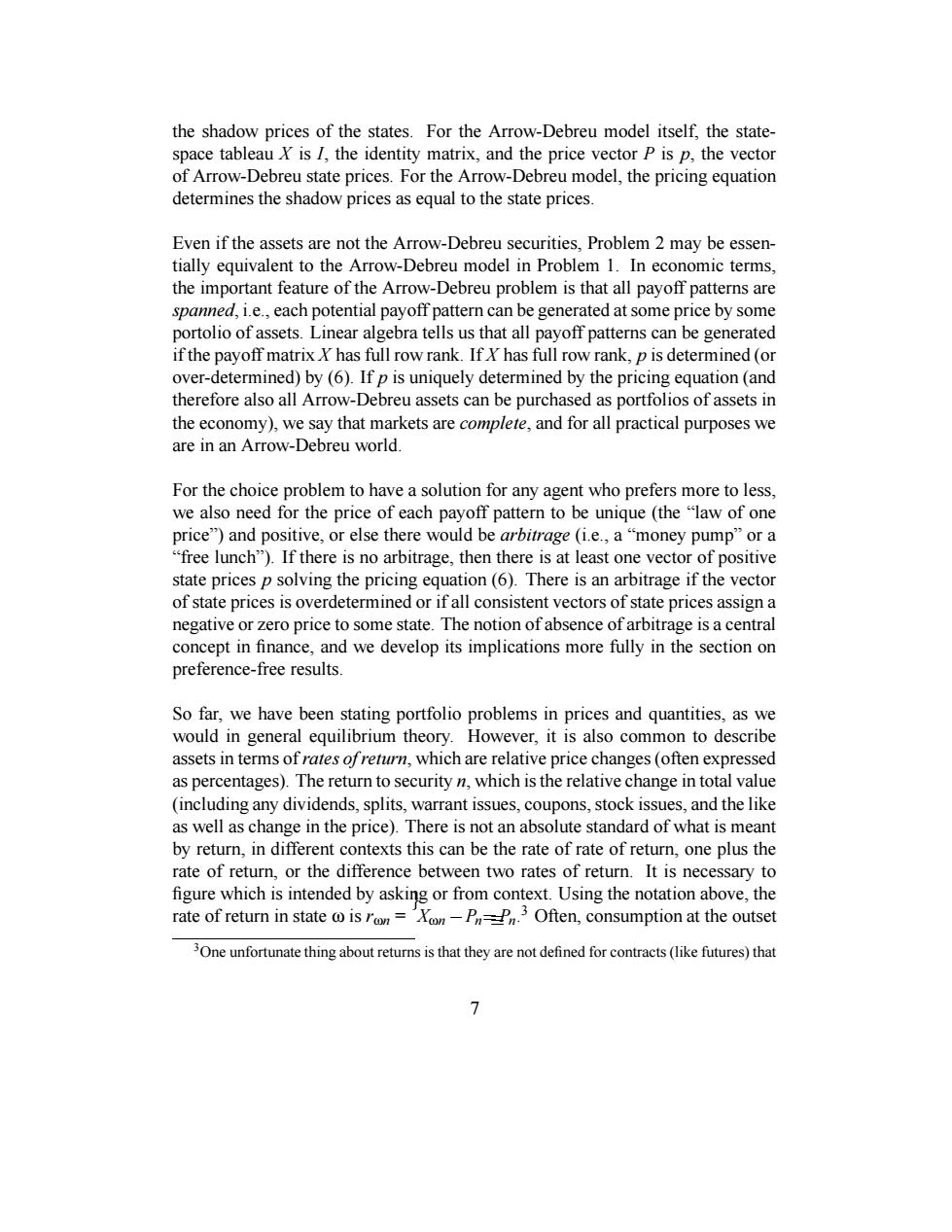正在加载图片...

the shadow prices of the states.For the Arrow-Debreu model itself,the state- space tableau X is I,the identity matrix,and the price vector P is p,the vector of Arrow-Debreu state prices.For the Arrow-Debreu model,the pricing equation determines the shadow prices as equal to the state prices. Even if the assets are not the Arrow-Debreu securities,Problem 2 may be essen- tially equivalent to the Arrow-Debreu model in Problem 1.In economic terms, the important feature of the Arrow-Debreu problem is that all payoff patterns are spanned,i.e.,each potential payoff pattern can be generated at some price by some portolio of assets.Linear algebra tells us that all payoff patterns can be generated if the payoff matrix X has full row rank.If X has full row rank,p is determined (or over-determined)by(6).If p is uniquely determined by the pricing equation (and therefore also all Arrow-Debreu assets can be purchased as portfolios of assets in the economy),we say that markets are complete,and for all practical purposes we are in an Arrow-Debreu world. For the choice problem to have a solution for any agent who prefers more to less, we also need for the price of each payoff pattern to be unique (the "law of one price")and positive,or else there would be arbitrage (i.e.,a "money pump"or a "free lunch").If there is no arbitrage,then there is at least one vector of positive state prices p solving the pricing equation(6).There is an arbitrage if the vector of state prices is overdetermined or if all consistent vectors of state prices assign a negative or zero price to some state.The notion of absence of arbitrage is a central concept in finance,and we develop its implications more fully in the section on preference-free results. So far,we have been stating portfolio problems in prices and quantities,as we would in general equilibrium theory.However,it is also common to describe assets in terms of rates ofreturn,which are relative price changes (often expressed as percentages).The return to security n,which is the relative change in total value (including any dividends,splits,warrant issues,coupons,stock issues,and the like as well as change in the price).There is not an absolute standard of what is meant by return,in different contexts this can be the rate of rate of return,one plus the rate of return,or the difference between two rates of return.It is necessary to figure which is intended by asking or from context.Using the notation above,the rate of return in state is rn=n-P3Often,consumption at the outset 3One unfortunate thing about returns is that they are not defined for contracts(like futures)that 7the shadow prices of the states. For the Arrow-Debreu model itself, the statespace tableau X is I, the identity matrix, and the price vector P is p, the vector of Arrow-Debreu state prices. For the Arrow-Debreu model, the pricing equation determines the shadow prices as equal to the state prices. Even if the assets are not the Arrow-Debreu securities, Problem 2 may be essentially equivalent to the Arrow-Debreu model in Problem 1. In economic terms, the important feature of the Arrow-Debreu problem is that all payoff patterns are spanned, i.e., each potential payoff pattern can be generated atsome price by some portolio of assets. Linear algebra tells us that all payoff patterns can be generated if the payoff matrix X has full row rank. If X has full row rank, p is determined (or over-determined) by (6). If p is uniquely determined by the pricing equation (and therefore also all Arrow-Debreu assets can be purchased as portfolios of assets in the economy), we say that markets are complete, and for all practical purposes we are in an Arrow-Debreu world. For the choice problem to have a solution for any agent who prefers more to less, we also need for the price of each payoff pattern to be unique (the “law of one price”) and positive, or else there would be arbitrage (i.e., a “money pump” or a “free lunch”). If there is no arbitrage, then there is at least one vector of positive state prices p solving the pricing equation (6). There is an arbitrage if the vector of state prices is overdetermined or if all consistent vectors of state prices assign a negative or zero price to some state. The notion of absence of arbitrage is a central concept in finance, and we develop its implications more fully in the section on preference-free results. So far, we have been stating portfolio problems in prices and quantities, as we would in general equilibrium theory. However, it is also common to describe assets in terms of rates of return, which are relative price changes (often expressed as percentages). The return to security n, which isthe relative change in total value (including any dividends,splits, warrant issues, coupons, stock issues, and the like as well as change in the price). There is not an absolute standard of what is meant by return, in different contexts this can be the rate of rate of return, one plus the rate of return, or the difference between two rates of return. It is necessary to figure which is intended by asking or from context. Using the notation above, the rate of return in state ω is rωn = ✁ Xωn Pn ✂ Pn. 3 Often, consumption at the outset 3One unfortunate thing about returns is that they are not defined for contracts (like futures) that 7